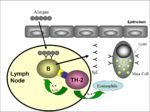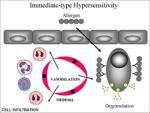Difference between revisions of "Type I Hypersensitivity"
Jump to navigation
Jump to search
| (29 intermediate revisions by 6 users not shown) | |||
| Line 1: | Line 1: | ||
| + | {{toplink | ||
| + | |backcolour = FFE4E1 | ||
| + | |linkpage =Immunology - WikiBlood | ||
| + | |linktext =IMMUNOLOGY | ||
| + | |sublink1 =Hypersensitivity - WikiBlood | ||
| + | |subtext1 =HYPERSENSITIVITY | ||
| + | |pagetype =Blood | ||
| + | }} | ||
==Introduction== | ==Introduction== | ||
| − | * Also known as | + | * Also known as IgE-mediated or anaphylactic hypersensitivity. |
* Ranges from mild cases, such as hayfever, to life-threatening reactions, such as bee-stings. | * Ranges from mild cases, such as hayfever, to life-threatening reactions, such as bee-stings. | ||
* Antigens that induce a type I reaction are known as allergens. | * Antigens that induce a type I reaction are known as allergens. | ||
* Generally affects face, eyes, nose and feet | * Generally affects face, eyes, nose and feet | ||
| − | * | + | * IgE has a high affinity to IgE receptors on mast cells and basophils, and so binds these receptors. |
| + | |||
==Common allergens which elict a type I hypersensitivity reaction:== | ==Common allergens which elict a type I hypersensitivity reaction:== | ||
| Line 19: | Line 28: | ||
[[Image:Sensitisation phase1.jpg|right|thumb|150px|IMAGE 1: Sensitisation phase1.jpg | [[Image:Sensitisation phase1.jpg|right|thumb|150px|IMAGE 1: Sensitisation phase1.jpg | ||
-Brian Catchpole RVC 2008]] | -Brian Catchpole RVC 2008]] | ||
| − | [[Image:Immediate-type hypersensitivity.jpg|right|thumb|150px|IMAGE 2: | + | [[Image:Immediate-type hypersensitivity.jpg|right|thumb|150px|IMAGE 2: Immesdiate-type hypersensitivity-Brian Catchpole/M Maidment RVC 2008]] |
| Line 29: | Line 38: | ||
'''2. Subsequent exposure to the specific allergen (Image 2):''' | '''2. Subsequent exposure to the specific allergen (Image 2):''' | ||
| − | * | + | * mast cell degranulation. |
| − | * | + | * basophils with IgE receptors are recruited and also degranulate. |
| − | Mast cells secrete mediators: | + | Mast cells secrete mediators which cause: |
| − | * The release of inflammatary | + | * The release of inflammatary cytokines |
**Steroid mediators, e.g. prostaglandins and leukotriens | **Steroid mediators, e.g. prostaglandins and leukotriens | ||
| − | + | *Chemoattractants (attracts mainly neutrophils but also eosinophils, monocytes and basophils and plasma) | |
| − | + | *Some mast cell cytokines (especially eosinophils) release factors which promote growth and maturation of leukocytes | |
| − | + | *Vasoactive and inflammatory peptides (e.g. histamine and serotonin) which causes acute contraction of smooth muscle fibres | |
| − | * | + | **Leading to bronchoconstriction and vasoconstriction (if the allergen is ) |
| − | + | **Violent constriction can lead to the expulsion of parasites | |
| − | + | *The release of mast cell proteases | |
| − | + | **Promotes mucous production | |
| − | + | **Inhibits parasite interactions with the epithelial surface | |
| − | + | * Vasodilation (leads to redness and heat) | |
| − | + | * Oedema (from leaky blood vessels) | |
'''3. The late phase response:''' | '''3. The late phase response:''' | ||
| − | * Mediated by | + | * Mediated by eosinophils. |
* Takes longer (several hours) as the eosinophils are mobilised from the bone marrow. | * Takes longer (several hours) as the eosinophils are mobilised from the bone marrow. | ||
| Line 55: | Line 64: | ||
===Examples of Type I hypersensitivity=== | ===Examples of Type I hypersensitivity=== | ||
| − | * | + | * Atopy |
| − | * | + | * Flea allergic dermatitis |
| − | * | + | * Sweet itch |
| − | |||
| − | |||
| − | |||
| − | |||
| − | |||
| − | |||
| − | |||
| − | |||
| − | |||
| − | |||
| − | |||
| − | |||
| − | |||
| − | |||
| − | |||
| − | |||
| − | |||
| − | |||
| − | |||
| − | |||
| − | |||
| − | |||
| − | |||
| − | |||
| − | |||
Revision as of 11:39, 29 August 2008
|
|
Introduction
- Also known as IgE-mediated or anaphylactic hypersensitivity.
- Ranges from mild cases, such as hayfever, to life-threatening reactions, such as bee-stings.
- Antigens that induce a type I reaction are known as allergens.
- Generally affects face, eyes, nose and feet
- IgE has a high affinity to IgE receptors on mast cells and basophils, and so binds these receptors.
Common allergens which elict a type I hypersensitivity reaction:
- Proteins : Foreign serum
- Plant pollens : Rye grass, ragweed, timothy grass, birch trees
- Drugs : Penicillin, sulphonamides, local anaesthetics, salicylates
- Foods : Nuts, seafood, eggs, milk
- Insect products : Bee venom, wasp venom, dust mites faeces, flea saliva
Mechanism
1. Initial antigen exposure sensitises immune system (Image 1):
- Allergen exposure causes IgE production.
- IgE coat mast cells by binding to Fc receptors.
- Mast cells are now sensitised to this particular allergen.
2. Subsequent exposure to the specific allergen (Image 2):
- mast cell degranulation.
- basophils with IgE receptors are recruited and also degranulate.
Mast cells secrete mediators which cause:
- The release of inflammatary cytokines
- Steroid mediators, e.g. prostaglandins and leukotriens
- Chemoattractants (attracts mainly neutrophils but also eosinophils, monocytes and basophils and plasma)
- Some mast cell cytokines (especially eosinophils) release factors which promote growth and maturation of leukocytes
- Vasoactive and inflammatory peptides (e.g. histamine and serotonin) which causes acute contraction of smooth muscle fibres
- Leading to bronchoconstriction and vasoconstriction (if the allergen is )
- Violent constriction can lead to the expulsion of parasites
- The release of mast cell proteases
- Promotes mucous production
- Inhibits parasite interactions with the epithelial surface
- Vasodilation (leads to redness and heat)
- Oedema (from leaky blood vessels)
3. The late phase response:
- Mediated by eosinophils.
- Takes longer (several hours) as the eosinophils are mobilised from the bone marrow.
Examples of Type I hypersensitivity
- Atopy
- Flea allergic dermatitis
- Sweet itch

